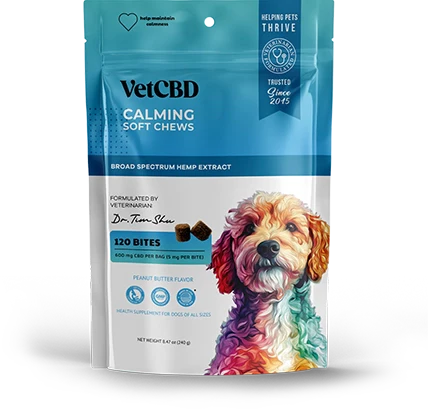
Cannabis For Dogs: When To Use It and Why
Share
With proper use and application, cannabis has become a go-to option for many pet parents wanting to support their furry friends. Cannabis for dogs may seem an unconventional solution, but a growing number of companies have made this alternative treatment option not only possible, but also safe and reliable.
Before we dive into cannabis for dogs, a quick definition of cannabis: cannabis is the shorthand for the plant Cannabis sativa, which is where extracts like CBD and THC are pulled from. Hemp is a type of Cannabis sativa plant, but one bred to have almost no THC and high levels of CBD.
Veterinarian-based research has shown that cannabis products like CBD dog treats and pet CBD tinctures have the potential to support pets’ overall health and wellness with few (if any) side effects. And best, when formulated correctly, the right cannabis products won't get your dogs high, keeping them safe from risks of toxicity and associated unpleasant central nervous system symptoms.
Finding the correct cannabis products for your dog will be essential to keeping them supported and safe.
Read on to find out which cannabis products are okay for dogs and which are not.
CBD vs. THC: Which Is OK for Dogs?
Cannabis comes in a range of products acceptable for humans, but not all types of cannabis are equally appropriate for your canine accomplaces. So before you go and share your own cannabis wellness products with your pup, let’s go through what types of cannabis are safe for pets and what aren’t.CBD
CBD is the abbreviation for the compound cannabidiol, a compound that can be extracted from all types of cannabis. Generally, a type of cannabis strain known as indica is known to have more THC than CBD, and another specially-bred type of cannabis called hemp is known to have more CBD and virtually no THC. Thanks to the 2018 Farm Bill, hemp is federally legal to grow, process into products, and sell throughout the entire United States. That’s because THC, the controlled substance in any cannabis plant, is at such low levels (less than 0.3%, in fact) that no dose of CBD can cause the hallucinogenic effects associated with controlled cannabis. When this bill was passed, many, many CBD products were finally able to be properly grown, manufactured, and third-party tested to ensure potency and quality. As the benefits of CBD like supporting emotional balance and mobility became known in humans, it began to be manufactured for our animal companions, too, in hopes of extending the wellness benefits to them. As the World Health Organization has phrased it, there has yet to be any research showing any adverse side effects of CBD use in animals. Because of this, many pet owners have begun giving their pets daily doses of CBD to support various facets of health, as currently the research seems to support that there are more positive effects for CBD and almost no negative.THC Toxicity
The outlook for dogs and THC is a bit different. With THC and CBD both coming from the same plants, one may assume that their effects would be similar. However, there is a big difference in that while a huge dose of CBD doesn’t cause any very adverse effects in dogs, a very large dose of THC can be far too intense for them and can cause severe discomfort and anxiety because of THC’s psychoactive effects. Dogs don’t understand what’s happening when they start to feel those changes to their central nervous system, which is why although THC is safe for dogs to consume, it should only be consumed in animal-specific formulas that contain the appropriate amount for our pups. If your dog does get into your own THC-inclusive baked goods, gummies, etc., there are multiple symptoms that a dog might possibly have that can exhibit THC poisoning.- They may become disoriented and stumble around.
- They might also be unable to control their bodies and may suffer from tremors and shaking, bouts of vomiting, loss of bowel control, or urinary incontinence.
- They may become agitated, but they also have an equal amount of risk for becoming dull and lethargic.
- They may experience a loss of motor function, and may also begin drooling, shivering, barking, crying, or whining in a way unusual to their typical behavior. Low blood pressure is also a possibility.


